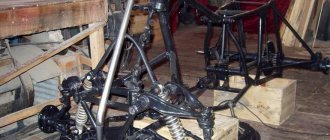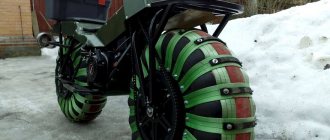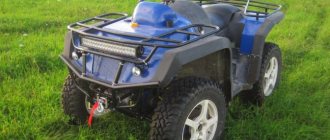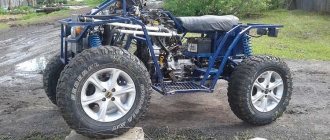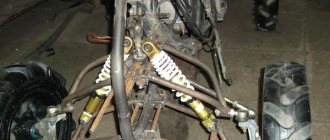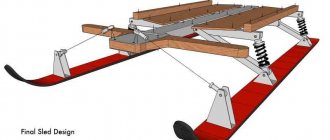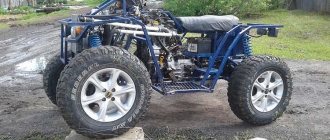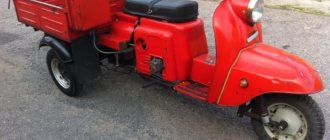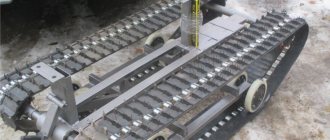Cars admin26.02.2020
The question of how to start an ATV often arises among beginners. However, experienced users may encounter a situation where the vehicle does not start for some reason. In this case, you need to figure out what's wrong and fix the problem.
If you have become the proud owner of an all-terrain vehicle, you may have many questions about its operation, for example, how to start a four-wheeler. New models are equipped with an electronic starter. Therefore, startup problems almost never arise. But used older models may have a manual kick starter installed. Beginners sometimes have difficulties with it. Although this is a matter of experience. To start the ATV, you need to do the following:
- Check the presence of fuel in the tank and the position of the ignition key. It should be in the "on" position. Also, the ignition switch should be in the "on" position on the control panel.
- The speed should be switched to neutral. You need to depress the clutch (if equipped), and then set the switch to the “neutral” position. At this point, a light usually comes on on the control panel. You can also try pushing the ATV. If the wheels spin, then everything is done correctly.
- If the ATV is cold, you need to pull the choke lever towards you. This will enrich the gasoline mixture with air. This will make starting a cold system easier. If the engine is warm, such manipulation is not required.
- If the model has an electric starter, just press and hold the corresponding button until the engine starts. If there is a kick starter, you need to sit on the all-terrain vehicle and press the starter until it starts. In both cases you need to squeeze the gas. The throttle valve will open, adding fuel to the engine.
- The choke lever is pressed back. As soon as the engine starts, the vehicle is ready to move.
Fuse blown
Another possible reason why your ATV won't start could be a blown fuse. If the all-terrain vehicle is small, there is usually only one fuse. It is located next to the battery. The suitability of this part for use can be assessed visually. The cost of the fuse is cheap, so it is better to have several of these parts in stock.
If there is no spare fuse, and the breakdown occurred far from home, you can insert a wire instead. This is a temporary solution that will allow you to get home. You cannot permanently replace a fuse with a wire. You can burn much more expensive elements of the system.
Common breakdowns
Lack of fuel in the tank
Paradoxically, sometimes ATV owners simply forget to pour gasoline into the tank. Therefore, before starting diagnostics, it is worth checking the fuel level.
Dead battery
There are often cases when the cause of the problem is insufficient battery charge . It can be charged at home. If the ATV is small, you can purchase an additional battery. The cost of batteries for budget models is relatively low.
How to Start an ATV?! If the battery is dead!? Lifehacks! Reply to subscriber | Irbis Atv 250s | SJ8Pro
Contact fault
If the battery is good, but the starter does not work, perhaps the cause should be looked for in the starting system. You need to try to close the contacts that are on the starter relay. To do this you will need to use a screwdriver. The relay is usually located under the seat. Two thick wires are connected to it.
If you want to find a way to start an ATV without a key, you can also follow similar steps. This technique will only be effective if the system is not controlled by a central computer . Otherwise, the lock will work.
If after these manipulations the engine starts, then the problem is in the starting system . Otherwise, you will need to look further for the cause of the malfunction or visit a service center.
Stop button
There is a “Stop” button on the steering wheel of each ATV. Usually it is red. This button is responsible for turning off the ignition; it turns off the engine . If you do not bring it back to its previous position, the engine, of course, will not start. Therefore, it is worth checking in what position the “Stop” button is located.
Pin fastened
Another safety system provided in ATVs is a special check. This is a cable that is attached at one end to the all-terrain vehicle, and at the other to the driver. If the latter falls off the ATV while driving, the pin flies out and the ignition is turned off. Without this check, you will also not be able to start the vehicle. If this part is lost, you will need to look for the corresponding contacts and close them directly.
Blown fuse
Another possible reason why your ATV won't start could be a blown fuse. If the ATV is small, there is usually only one fuse. It is located next to the battery . The suitability of this part for use can be assessed visually. The cost of the fuse is cheap, so it is better to have several of these parts in stock.
If there is no spare fuse, and the breakdown occurred far from home, you can insert a wire instead . This is a temporary solution that will allow you to get home. You cannot permanently replace a fuse with a wire. You can burn much more expensive elements of the system.
Switch failure
This part is located under the saddle or next to the motor (depending on the model). This is a small box with wires coming out of it. They are connected to the ignition coil. It is difficult to assess the serviceability of this part, so it is better to contact a service center with a similar problem.
No spark
If the spark plug wire breaks or the ignition coil breaks, checking the functionality of these systems is not difficult. The candle is unscrewed and inserted into the spark plug cap. Next, you need to attach it with the metal side to the engine and press the starter button. If there is no spark between the electrodes, this is a sign of failure. Try cleaning the spark plug electrodes and adjusting the gap between them.
If there is a spark, then the problem lies either in the spark plug cap or in the spark plug. You need to purchase a new part and replace it.
New comments
- Valve clearances? What happened 3 weeks 6 days ago
- Carburetor? 4 weeks 3 days ago
- Practically. Except 4 weeks 3 days ago
- Check for spark 8 weeks 22 hours ago
- If fuel is available. 8 weeks 22 hours ago
- I tried it, they got up like 15 weeks 4 days ago
- I ordered a cast disc for stealth 15 weeks 5 days ago
- Thank you very much 16 weeks 4 days ago
- There is no separate box here 17 weeks 8 hours ago
- People tell me where 17 weeks 20 hours ago
Instructions for starting the engine (children's ATVs, minimotos, minicrosses 49cc 2t).
Sequencing:
1. Fill with fuel (for 1 liter of AI-92 gasoline - 40 ml of two-stroke semi-synthetic oil)
2. Turn the ignition switch to the “on” position
3. Check the position of the emergency engine shutdown pin on the steering wheel (it should fit tightly in place).
4. Turn the gas valve on the carburetor to a vertical position, wait 1 minute. until fuel enters the carburetor.
5. Lift the choke on the carburetor up.
6. Carefully and smoothly, without unnecessary force, pull out the starter cable (sharp pulling with great force, pulling the cable all the way to the limiter or to the side is not allowed). Failure to follow these recommendations may result in damage to the starter. The warranty does not cover the starter and clutch.
7. After starting the engine (after 3-10 seconds), lower the air damper on the carburetor down.
8. Let the engine warm up at idle speed (depending on the air temperature for 1-5 minutes).
If the engine does not start:
1. For a more confident engine start, especially in the cold season, purchase a “Quick Start” aerosol and before starting, spray it on the air filter with 1-2 clicks on the canister nozzle.
2. Check whether the throttle valve cover is screwed in completely; if not, tighten it.
3. The engine may not start due to insufficient idle speed - to raise it, tighten the screw 1-1.5 turns clockwise.
4. If the engine does not start after a long period of parking, it is necessary to drain the stagnant gasoline from the carburetor. Remove the bottom carburetor drain screw and allow the fuel to drain. Before starting, we recommend performing this procedure 3-5 times.
Running in a new engine:
For reliable and long-term operation of your equipment, it is necessary to run it in - a gentle operating mode:
1. During the break-in period, the proportion of the fuel mixture is 1:20 (1 liter of AI-92 + 50 ml of oil).
2. Start the engine, idle 1 tank of fuel.
3. During break-in, do not open the throttle lever more than ½, do not overload the equipment, do not let the engine overheat - cool the engine every 15-30 minutes.
4. Run-in is completed after 5 full gas tanks have been used up.
5. After break-in, avoid long-term operation with the throttle lever fully depressed.
Source
with kickstarter yes, with electric starter no
with kickstarter yes, with electric starter no
#1 Post by Alex999 » Tue Nov 14, 2017 17:48
Motorcycle Keeway Starlight 150, small Chinese.
It starts from kickstarter in any condition - with half a turn, even hot or cold.
But with an electric starter, no. You twist and twist (fortunately, the battery is fresh) - and it doesn’t even sneeze. I can’t imagine - how can this be??
There shouldn't be such nonsense. If it starts from the claw, then it should start instantly from the starter, but no, it starts from the starter extremely rarely; more often it doesn’t start than it starts.
Does the spark disappear during startup?
Re: kickstarter yes, electric starter no
#2 Post by XPOH » Tue Nov 14, 2022 05:55 pm
Re: kickstarter yes, electric starter no
#3 Post by Michael13 » Tue Nov 14, 2017 6:00 pm
Re: kickstarter yes, electric starter no
#4 Post by Alex999 » Tue Nov 14, 2017 18:01
How to teach a child to ride an ATV
You can start by buying a children's ATV or renting one from friends whose children are already grown. But what then? And then there will be training. Your task is not to teach your child to drive fast, but to teach him to drive correctly and safely. Speed will come on its own. I will describe to you eight simple exercises, for which you will only need a flat clearing and eight traffic cones.
Exercise 1. Start and stop
Arrange eight cones in a square with rounded corners. The task is to smoothly start from the cone of the beginning of the side of the square and smoothly stop exactly at the cone at the end of it. Smoothness and precision are needed. When braking, be sure to use both brakes - front and rear; this should become a habit. Drive the rounded part of the trajectory at minimum speed.
Exercise 2. Turns
Without rearranging the cones or changing the trajectory, we launch along a square with rounded corners. Before entering a turn, let him slow down using both brakes and shift his body weight slightly to the inside of the turn. After cornering, it accelerates smoothly. We start at a slow speed and gradually increase it. When you get tired, change the direction of movement. In this exercise, you need to ensure that the child transfers his body weight inside the turn, slightly moving his butt sideways on the seat and tilting his torso forward and sideways. The eyes are looking at the exit from the turn, the inside arm is bent at the elbow, the elbow is raised and also points to the exit from the turn. When driving on straight sections, let it sit straight. Alternate between riding clockwise and counterclockwise.
Exercise 3. In a circle
Rearrange the four cones a little - make the trajectory circular. The purpose of the exercise is to feel the limits of lateral grip of tires, feel lateral slip, and resist rollover. Hanging down, we drive in a circle, gradually increasing speed. At some point, the child reaches a speed at which either the rear axle begins to skid to the outside of the turn, or the inner wheels hang out in the air. Explain that both are “caught” by turning the steering wheel slightly in the direction of skidding (or capsizing). We gradually achieve an instant and quick reaction of his body without the participation of the brain. We regularly change the direction of movement to prevent dizziness.
Exercise 4. Eight
The purpose of the exercise is to teach how to move your body weight from one side to the other. We arrange eight cones in the form of four rhombuses. The transfer of body weight must occur to the point of overlap of the trajectories. Start the exercise at a low, constant speed, carefully monitoring your body position. Gradually allow increasing speed, accelerating after passing one semicircle and braking before entering the second.
ELECTRIC ATV WITH YOUR OWN HANDS: ENGINE AND BATTERY
The battery and engine for a homemade ATV are selected based on the capabilities and needs of the driver. So, you can use a couple of engines from a Volga or a screwdriver, take an electric motor from a donor vehicle (for example, an electric scooter), or use your own idea. The main thing is that the electric motor provides sufficient speed for the child - 5-8 km/h is enough for the smallest ones, older children will need a higher speed, which means a more powerful motor.
As for the battery, it is important to install it in such a way that there is no need to disassemble the entire structure to recharge. A battery from a donor scooter, uninterruptible power supply, or another one you can find will do.
When all the main components are assembled, it’s time to deal with the appearance of the ATV - after all, aesthetics are extremely important for the baby. Ideally, you can use body kit elements from an old non-working model of a children's ATV, but your imagination can give you other original ideas.
Working on assembling an ATV will not only allow you to get a unique vehicle for little money. It will bring pleasure not only to adults, but also to children, since making a children's ATV with your own hands is a fascinating activity, very interesting and useful for every man.
Operating instructions for two-stroke ATVs
Before operating a children's ATV, carefully read the safety requirements. The ATV is designed to transport children and cargo weighing up to 95 kg. The ATV is not intended for use on public roads.
1. When using an ATV, be sure to follow basic safety rules:
2. Running in a new engine:
For long and reliable operation of your equipment, it is necessary to break it in - use it in a gentle operating mode:
3. Instructions for starting a two-stroke engine.
3.1. First, fill in the fuel (for 1 liter of AI-92 gasoline - 40 ml of two-stroke semi-synthetic oil, 2T).
3.2. Turn the ignition key to the “on” position.
3.3. Check the emergency pin on the steering wheel (it should be firmly in place) and the engine stop button (it should be in its original position).
3.4. Turn the gasoline supply valve on the carburetor to the vertical position, wait 1-2 minutes until the fuel enters the carburetor.
3.5. Lift up the air damper on the carburetor.
3.6. Carefully and smoothly, without applying unnecessary force, pull out the starter cable. Sudden pulling of the cable, or pulling it all the way, can lead to damage to the starter.
3.7. After starting the engine (after 3-10 seconds), lower the air damper on the carburetor down.
3.8. Give the engine time to warm up at idle speed (warm-up time ranges from 1 to 5 minutes depending on the air temperature).
3.9. If your ATV is equipped with an electric starter, hold the brake and press the yellow electric starter button.
Example of starting a two-stroke ATV engine:
4. What to do if the engine does not start:
4.1. To start the engine in the cold season, purchase a “Quick Start” aerosol and spray it on the air filter before starting.
4.2. Check the throttle cover to see if it is screwed in completely; if not, tighten it.
4.3. If the engine does not start, it may not have enough idle speed - in order to raise it, tighten the screw clockwise 1-1.5 turns.
4.4. If the engine does not start after a long break, for example, idle time at the dacha or in the garage, you need to drain the fuel that has stagnated in the carburetor, as it has lost its quality. Unscrew the carburetor drain screw and allow the gasoline to drain.
5. Driving a quad bike.
5.1. Introducing a child to an ATV.
Children's petrol two-stroke ATV is designed for country recreation and entertainment of children and teenagers. This manual contains general rules for operating an ATV for recreational purposes. Driving an ATV on your own requires experience and skills from kids that they can only gain through practice under adult supervision. Take the time to teach your child basic techniques and control techniques, and only then allow him to control independently and perform more complex maneuvers.
Driving an ATV for a child is a very exciting activity that will bring a lot of pleasure to the child. But it is very important from the very beginning to carefully familiarize yourself with all the driving rules and acquire the skills that are simply necessary for your child to enjoy a comfortable and safe ride.
Before you start teaching your child the basics of driving, carefully read the Operating and Safety Instructions and try to explain to your child the principle of operation of all the main controls of the ATV. Pay special attention to safety requirements.
5.2. Speed limiter.
Especially for the youngest drivers who have no experience in operating such equipment, all children's ATVs are equipped with a speed limiter, which is located in the throttle lever housing. The speed limiter allows you to set the maximum power and speed of the ATV. When screwing in the adjusting screw, the possibility of pressure on the throttle trigger decreases, and when screwing it out, it increases.
I can't start the 500gt
I drove into the garage under my own power, sat there for 2 months, can’t start it. Neither manual nor electric starter. I unscrewed the spark plug and it’s wet, which means there’s fuel. I check, there’s a spark on the spark plug, I checked it on both the manual and electric starters. They give me a spark. I tried different ones spark plugs, one original, second DENSO from the catalogue. He won’t even sneeze. In 1995 there was such a thing at a VAZ, there was a spark, there was gasoline. We replaced the coil and drove off. As they explained to me, it gives a spark at the wrong time. The trouble is that it’s impossible to find the reason at random, there’s nowhere to get a stealth coil and a switch. Tell me, has anyone encountered this?
Lighting up the car
When choosing this method, you should take into account the fact that a sharp voltage surge appears in the vehicle’s on-board network, which can damage all sensitive electronics and the on-board vehicle. When using a cigarette lighter to start the engine, you should turn off all sensitive devices. To light a cigarette, you need a donor car and a set of high-voltage wires, with the help of which both batteries are connected, strictly observing the polarity. battery for 5-10 minutes . Then, turning off the donor car , they start their engine. If there is no positive result, the procedure must be repeated, but you should start with the assistant engine turned on (it is advisable to keep the speed at about 2000 rpm). If the result is positive, the wires should be immediately removed and proceeded to a place where the battery can be fully charged as usual.

